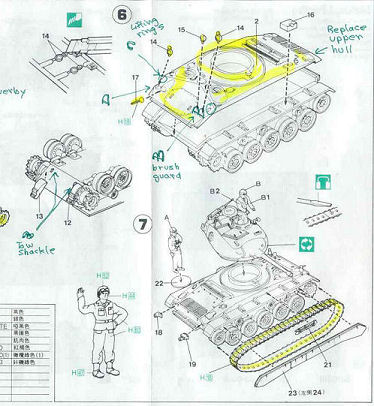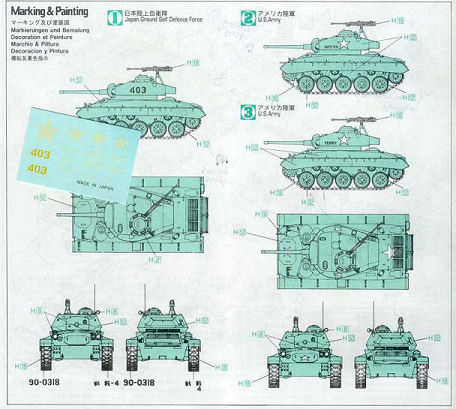| Hasegawa
|
www.onthewaymodels.com | M24 Chaffee | |||
Kits used :
|
Review
by Stephen 'Tank Whisperer' Brezinski Edited by Marc Mercier |
||||
| Hasegawa
|
www.onthewaymodels.com | M24 Chaffee | |||
Kits used :
|
Review
by Stephen 'Tank Whisperer' Brezinski Edited by Marc Mercier |
||||
First off, Overby's Motor Pool designation of this kit MP032 has been taken over from a previous Motor Pool kit, an M4A6 Sherman hull conversion. The M24 Chaffee is a late World War 2 light tank to replace the M3 and M5 Stuart light tanks. Compared to the M3 and M5, the M24 features a larger 75-mm main gun, lower profile and torsion bar suspension. The M24 can be modeled in service with US forces in late 1944-45 Europe, in Korea, the French and Vietnamese Armies, Japanese Self Defense Forces and others. The M24 also served as the basis for several self-propelled weapons. |
||
A look At The Box Art and Vehicle Features Looking at the kit's box art we have a dynamic scene of attacking M24 accompanied by an M4A3E8 and infantry, so this could be likely be set either NW Europe in 1945 or Korea 1950 to 1952. Color is an overall olive green with white stars and no other discernible marking other than what appears to be a small circle on the left (our right) mudguard. Starting at the top we have a commander figure in the direct-vision cupola, a similar cupola to that on the late M4 Sherman, except it is mounted on the opposite side of the turret roof than on the Sherman. None of the other hatches are portrayed open. The commander is manning a 50 cal. machine gun on a pedestal mount; many M24's had a tripod mount behind the turret hatches. The welded steel turret has a cast steel gun mantlet with the gunner's sight evident.
|
||
On the glacis of the hull is the hull machine gun and a large bolted-on access hatch for the transmission and brakes. The hatch has two handles we can model with thin wire There are brush guards around the headlights. In front of the driver's hatch is a driver's windshield that is folded down; I do not think this windshield would be left on when going into combat. The front towing shackles are similar to those on the late Sherman with a tow cable attached on the tanks left side. On the outer side of the tow shackles are bolted plates for attaching a bulldozer blade, bulldozer mounting pads, assembly which is characteristic of a late M24. The suspension consists of five large paired roadwheels with a front drive sprocket that looks similar to those used on the M4 Sherman except that it (and the idler wheel) have lightening holes visible around the inside. We can also make out two of the three return rollers, and shock absorbers behind the roadwheels. This M24 is portrayed with the T72E1 Steel Track which is an initial track type used (but this is not the track type supplied with Hasegawa's model kit).
|
||
Left is a photo of an M24 Chaffee from a US government publication including a spiffy 2-view profile with size measurements to help us evaluate accurate scale of our built model. From the top we have the small spotlight similar to that mounted on the M4 Sherman. To the left is the 50-cal machine gun mounted on a tripod mount behind the loader's hatch. T72E1 Steel Track Right of the main gun is the coaxial machine gun protruding from the mantlet. On the glacis we can make out the bracket for the driver's folding windshield but no windshield installed. Also on the glacis is the octagonal access plate but this vehicle has a raised lip around the access plate. All my M24 reference photos show this lip which I would guess is to inhibit bullet splash. In the center of the roof next to the driver's hatch is the ventilation fan dome. This M24 wears the side, sand skirts but I have read that these skirts were often removed when in combat. On the lower front plate we see bent two rod steps that I have read are typical of the initial production, early, M24 before the bulldozer mounting pads were fitted. These features would be common of a WW2 era M24. |
||
The Kit Parts Within Overby's Motor Pool we have 104 cast resin parts on 12 pour plugs to upgrade and make more accurate the Hasegawa kit. Thirty seven of these parts are the link & length tracks. The parts are packaged loose in a small ziplock bag. Molding quality is good though I have found some thin spots on the sprocket wheels. There are some small air bubbles and some thin flash to remove. No etched metal or figures are included. Though unpadded, none of my parts were broken. Within
the Hasegawa kit we get 68 pale gray, injection molded styrene plastic
parts on two sprue, packed in a plastic bag and a cardboard box typical
of1/72-scale Hasegawa kits. Molding quality is good, no flash or significant
sink holes which is all typical of Hasegawa small scale armor. |
||
Right is Hasegawa's sprue-A with Motor Pool's replacement cast resin upper hull at the upper left. The long fender-like part on the left side of the Motor Pool hull is part of the pour plug and is to be cut off, it is not a fender, mudguard. Motor Pool's hull has thin flash over the driver's hatches meant to be cut out so the hatches can be modeled open, and yes, Motor Pool supplies separate resin driver's hatches. The Motor Pool upper hull is designed to fit down onto Hasegawa's lower hull part-1. In the center of Hasegawa's sprue are the two crew figures and the lower hull sides holding the suspension points and shock absorbers. |
||
At far left are two pore plugs holding additional parts, and replacement parts for the Hasegawa kit. Detail and casting look pretty good. |
||
Motor
Pool supplies replacement outer roadwheels that mount onto Hasegawa's
inner roadwheels parts-10 and replace Hasegawa's outer roadwheels
parts-9. Motor Pool also supplies new resin sprocket wheels and a
replacement return and idler wheel parts. I have found some air bubbles
in some of the wheels that can easily be filled with super glue gel
or model putty.
At the very bottom of Motor Pool's sprue at right are several nicely rendered antenna mounts. |
|
|
Here is another view of the wheels parts, and two additional Motor Pool pore plugs of parts, including very nice headlight brush guards, spotlights, towing pintle and lifting rings. |
||
Motor Pool gives us cast resin link & length track parts representing the T72E1 Steel Track typical of the track used during WW2. The resin track has good exterior detail and had track guide teeth but no hinge detail on the inner face; we can crudely simulate the track hinge detail with some fine, shallow, saw cuts. What Hasegawa supplies with their M24 kit is a soft plastic rendition of T85E1 Rubber Track used by later M24 tanks such as during the Korean War. Hasegawa's tracks also lack the track link hinge detail on the inside surface.
|
||
| Kit Instructions | ||
Hasegawa's exploded view kit instructions are clear and typical for all their small scale AFV kits. I received no assembly instructions for Motor Pool's upgrade kit so I have highlighted in yellow the parts on Hasegawa's instructions to help with replacement of the Hasegawa parts and with assembly of the Motor Pool conversion. |
||
|
Hasegawa's two crew figures were good for the time
this model was released but by today's standards appear stiff and
with soft features.
Hasegawa's parts 12 and 13 on the lower bow can be replaced by two Motor Pool parts that do not have the bolts for the bulldozer mounting pads, converting the Hasegawa model to a WW2 version of the M24. |
 |
|
Hasegawa
offers water slide decal markings for two US Army M24s and an M24
of the Japan Ground Self Defense Forces, but no unit information is
supplied. Unfortunately the markings on the small decal sheet are
difficult to see in this scan. |
 |
|
Conclusion The Hasegawa kit can be built into a good display model as is, or improved with some scratchbuilt details, or greatly improved and made into a WW2 version with the Motor Pool conversion and upgrade kit. This kit was purchased by the reviewer References M24 CHAFFEE In Action, Armor Number 25, Squadron Signal Publications, by Jim Mesko et al (1988). ISBN 0-89747-205-5
|
||
Back to : |
|
Article Last Updated: 30 June 2014 |